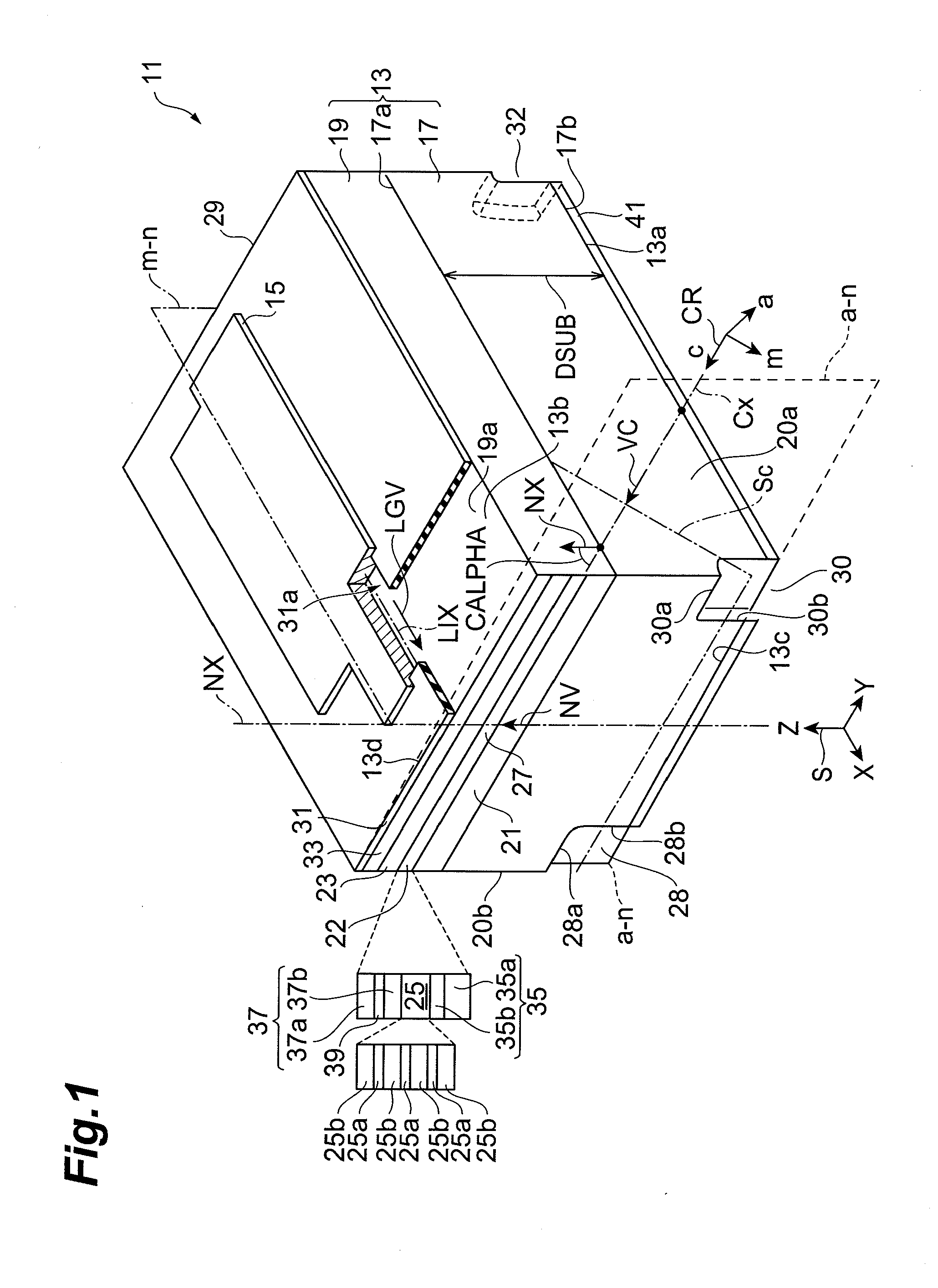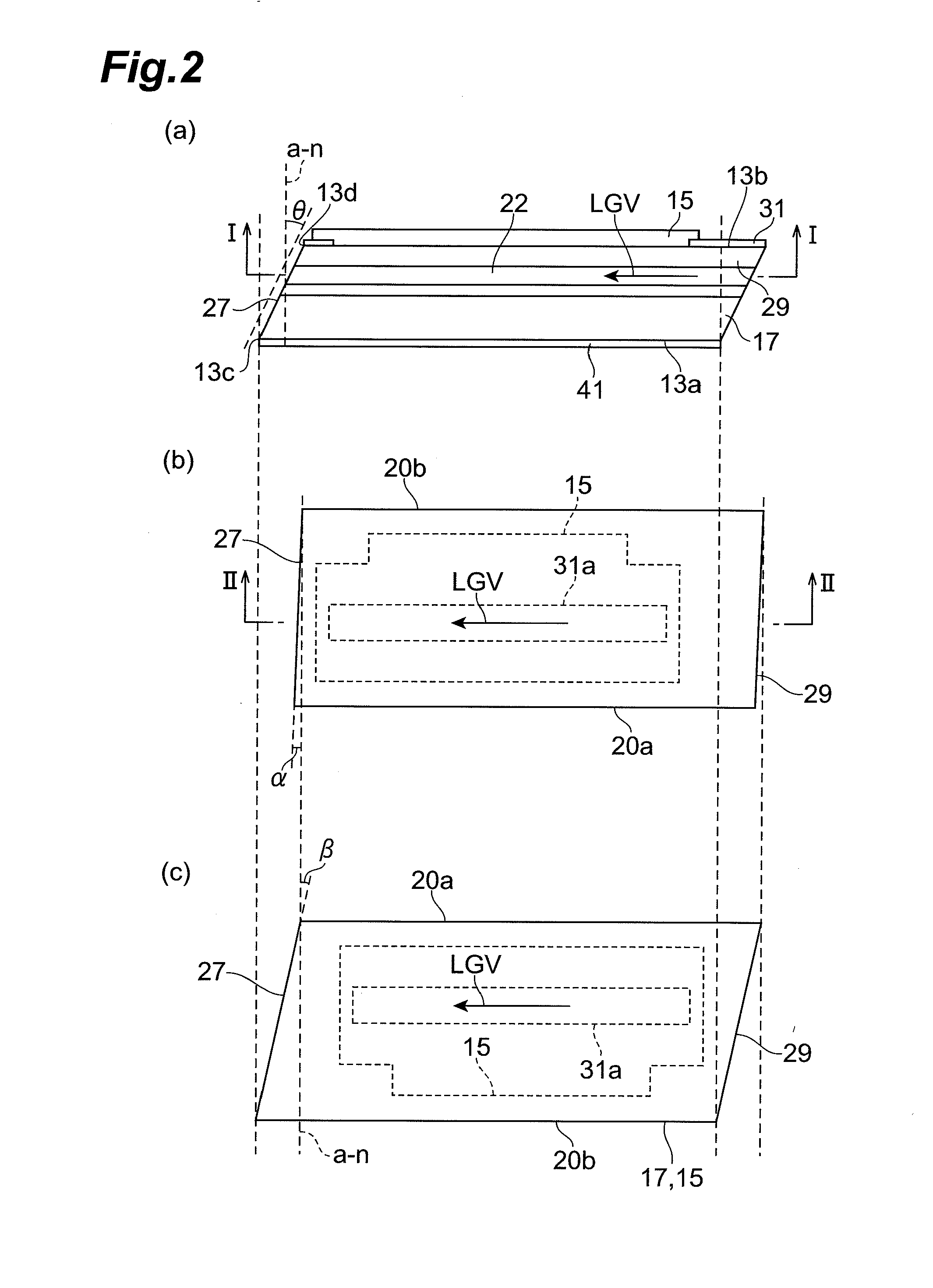Group-iii nitride semiconductor laser device, and method of fabricating group-iii nitride semiconductor laser device
a laser device and nitride technology, applied in the direction of semiconductor lasers, laser optical resonator construction, laser details, etc., can solve the problems of unable to produce cavity mirrors by using conventional cleaved facets, unable to achieve laser waveguide orientation, and heavy process conditions
- Summary
- Abstract
- Description
- Claims
- Application Information
AI Technical Summary
Benefits of technology
Problems solved by technology
Method used
Image
Examples
example 1
[0144]A semipolar-plane GaN substrate is prepared and perpendicularity of a fractured face is observed as described below. A {20-21}-plane GaN substrate is used as the substrate, which is cut at the angle of 75 degrees toward the m-axis out of a (0001) GaN ingot thickly grown by HVPE. The primary surface of the GaN substrate is mirror-finished, and the back surface is in a ground pear-skin state. The thickness of the substrate is 370 μm.
[0145]On the back side in the pear-skin state, a marking line is drawn perpendicularly to the direction of the projected c-axis onto the primary surface of the substrate with a diamond pen, and thereafter the substrate is fractured by press. For observing the perpendicularity of the resultant fractured face, the substrate is observed from the a-plane direction with a scanning electron microscope.
[0146]Part (a) of FIG. 8 shows a scanning electron microscope image of the fractured face observed from the a-plane direction, and the right end face is the ...
example 2
[0147]Example 1 shows that, in the GaN substrate having the semipolar {20-21} plane, the fractured face is obtained by drawing the marking line perpendicular to the direction of the c-axis projected onto the primary surface of the substrate and pressing the substrate, and has the flatness and perpendicularity to the primary surface of the substrate. For checking applicability of this fractured face to the laser cavity, a laser diode shown in FIG. 9 is grown by metal-organic vapor phase epitaxy as described below. The raw materials used are trimethyl gallium (TMGa), trimethyl aluminum (TMAl), trimethyl indium (TMIn), ammonia (NH3), and silane (SiH4). A substrate 71 is prepared. The substrate 71 prepared is a GaN substrate formed by cutting at an angle in the range of zero degrees to 90 degrees toward the m-axis out of a (0001) GaN ingot, thickly grown by HYPE, with a wafer slicing apparatus in such a manner that the angle CALPHA of inclination of the c-axis toward the m-axis has a de...
example 3
[0164]In Example 2, the plural epitaxial films for the semiconductor laser are grown on the GaN substrate having the {20-21} plane. The end faces for the optical cavity are formed by the formation of scribed grooves and the press as described above. In order to find candidates for these end faces, plane orientations which make an angle near 90 degrees with the (20-21) plane and are different from the a-plane are obtained by calculation. With reference to FIG. 14, the following angles and plane orientations have angles near 90 degrees to the (20-21) plane.
Specific plane index,Angle to {20-21} plane.(−1016):92.46 degrees;(−1017):90.10 degrees;(−1018):88.29 degrees.
PUM
| Property | Measurement | Unit |
|---|---|---|
| angle | aaaaa | aaaaa |
| angle | aaaaa | aaaaa |
| angle | aaaaa | aaaaa |
Abstract
Description
Claims
Application Information
 Login to View More
Login to View More - R&D
- Intellectual Property
- Life Sciences
- Materials
- Tech Scout
- Unparalleled Data Quality
- Higher Quality Content
- 60% Fewer Hallucinations
Browse by: Latest US Patents, China's latest patents, Technical Efficacy Thesaurus, Application Domain, Technology Topic, Popular Technical Reports.
© 2025 PatSnap. All rights reserved.Legal|Privacy policy|Modern Slavery Act Transparency Statement|Sitemap|About US| Contact US: help@patsnap.com



